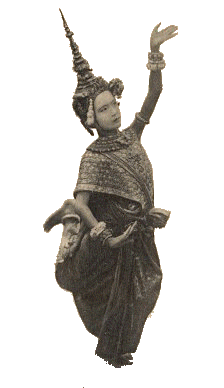|
HINDU SURAS - APSARA
The Apsaras are celestial nymphs, the
dancers in the court of Indra, the king
of the Devas. All of them are extremely
beautiful and skilled in both dance and
music. They occur in Persian mythology
also, but there, they are water nymphs,
and are closely associated with
ApamNapat.
They are many in number, and the most
famous are Rambha, Menaka, Urvashi,
Tilottama and Ghritachi. Other nymphs
who are mentioned in the Puranas are:
Mishrakesi, Vapu, Viprachitti,
Purvachitti, Sahajanya, Karnika,
Punjikasthala, Viswachi, Rithisthala,
Umlocha, Pramlocha,
Swayamprabha,Janapadi, and Adrika. For
Tilottama and Urvashi, the story of
their origins is available, but the
others are believed to have sprung forth
from the ocean-of-milk when it was
churned by the Devas and Asuras.
They are closely associated with the
Gandharvas, who are the celestial
musicians. Some of the Apsaras are
paired with a Gandharva, such as Tumburu
with Rambha, and Menaka with Vishvavasu.
But the relationship is temporary and is
not a marriage tie.
In addition to entertaining at Indra's
court, they are often sent by him to
disrupt the penance of sages, for Indra
lives in perpetual fear that his
position would be usurped by some sage
by his ascetic merit. Sometimes, the
nymph would succeed in seducing the sage
and achieve her mission, at other times,
she would merely incur the wrath of the
sage, who would curse her. In the former
case, the children (almost always
female), born of such a union would be
abandoned, and would be brought up by
foster parents. Satyavati and Shakuntala
are such children, born respectively to
Adrika and Menaka.
If the Apsara were to fail in her mission, the sage
would curse her, typically to be turned into stone or some lower
animal, with the proviso that after the lapse of a certain amount of
time, or upon the occurrence of a particular event, they would
regain the original form and would return to heaven.
|

WORLD RELIGIONS
COMPARED
WORLD
RELIGIONS CLIPART
WORLD
RELIGIONS HOME
HINDUISM HOME
HINDU SPIRIT WORLD
HINDU SURAS |